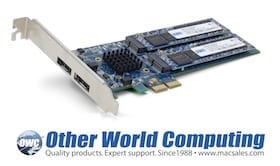
Other World Computing today introduced the OWC Mercury Accelsior_E2, a Mac and PC-bootable, high-performance PCIe SSD card that features up to 960GB of SSD capacity, up to 820MB/s of sustained data performance, and further external storage expansion capability with two 6Gb/s eSATA interface ports. Built to exceed the demanding needs of video editing and creative professionals, the Mercury Accelsior_E2 offers the best combination of speed, capacity, and connectivity for simultaneous internal and external storage performance.
Speeds Up Booting, App Launches, and Processor Intensive Processes
By utilizing the fastest data interface available in a Mac Pro or PC — the PCIe slot — the Accelsior_E2 offers nearly 3x the performance vs. an SSD in a SATA 2.0 3Gb/s drive bay with well beyond even 6Gb/s speeds of up to 820MB/s. Now owners of PCs and Apple Mac Pros can stop waiting for I/O-intensive apps like Photoshop, Final Cut Pro, or Avid Pro Tools to render, capture or process; as well as experience near instantaneous booting and application launches.
Adds Faster Than Factory Interface To Mac Pros
Featuring two 6Gb/s eSATA expansion interfaces, the Accelsior_E2 offers up to 6x faster file transfers and backups—600MB/s—than the fastest Mac Pro factory offered interface of FireWire 800, which offers up to 100MB/s speed. The two eSATA ports are fully bootable, and ideal for a variety of application requirements enabling for up to 32TB or more of additional external drive capacity.
Use with Laptops Too
The Accelsior_E2 isn’t just for desktop machine use. By utilizing an external PCIe expansion chassis equipped with Thunderbolt, such as the OWC Mercury Helios, the performance benefits of the Accelsior_E2 can also be enjoyed by customers with Mac or PC laptops that feature the 10Gb/s Thunderbolt interface.
Connect Single Solutions or Create RAID Array
Fully compatible with 1.5Gb/s, 3Gb/s, and/or 6Gb/s external drives, the Accelsior_E2 offers two eSATA storage expansion interfaces. Each interface can connect to a variety of OWC and NewerTech single and dual drive RAID solutions and other brand eSATA interface equipped solutions. By using Apple Disk Utility or SoftRAID with Macs, or various software RAID applications for PCs, customers can even create a RAID array among two connected drives.
A More Efficient and Reliable Computing Experience
Massively boosting data transfer rates is only one of the benefits to the Accelsior_E2. With its custom SandForce Driven™ OWC Mercury SSD blades, the Accelsior_E2 card enables Mac and PC users to enjoy a more responsive and productive computing experience along with cooler, quieter, and more energy efficient operation compared to standard hard drives. Those benefits don’t come at the expense of dependable use as SandForce RAISE™ technology provides RAID-like data redundancy protection and reliability.
Boosts Entry Level Server Applications and Gaming Too
In addition to video-editing and multimedia creation / management deployment, the Accelsior_E2 takes entry-level servers and even gaming to entirely new levels of performance. With up to 100,000 IOPS, business-critical applications like online transaction processing databases are given an instant boost. For gamers, the Mercury Accelsior_E2’s extreme performance speed dramatically reduces game level-loading, object streaming, and save times for more play time and less waiting.
Upgrade As Capacity Needs Grow
With OWC factory configurations from 120GB (2 x 60GB) up to 960GB (2 x 480GB) and the ability to upgrade to larger Mercury Accelsior SSD blades in the future, the Mercury Accelsior_E2 is future-ready for growing capacity needs.
User-Friendly, Professionally Robust
As easy to install as a memory module, yet robust enough to handle the rigors of professional multimedia production environments, the half-height Accelsior_E2 card is the clear choice for pro audio and video studios producing HD-quality work. This game-changing, high-performance upgrade is designed and built in the U.S. from domestic and imported parts and backed by a three-year warranty.
Pricing, Availability
The Mercury Accelsior_E2 PCIe SSD card is available for immediate ordering in the following dual Mercury Accelsior blade SSD capacity configurations:
- 120GB (2 x 64GB for 128GB total flash) $319.99
- 240GB (2 x 128GB for 256GB total flash) $479.99
- 480GB (2 x 256GB for 512GB total flash) $749.99
- 960GB (2 x 512GB for 1.0TB total flash) $1,329.99
The final capacity figures represent each drive’s useable capacity after the 7% over-provisioning allocation for wear-leveling and drive management. OWC Mercury brand SSDs use over-provisioning to ensure high reliability over the life of the drive, as well provide exceptional drive longevity and consistent, high data performance with I/O stability. Without this and other technologies built into OWC SSDs, other brand SSDs lose consistency and/or performance over time and/or as unused space on the drive declines.
Trade-In Program For Previous Accelsior Model To Be Announced
The previous model Mercury Accelsior PCIe SSD was introduced at the 2012 National Association of Broadcasters (NAB) show and did not feature eSATA expansion capability. To offer owners a cost-effective upgrade path to the current Accelsior_E2, OWC will soon announce a trade-in rebate program. Along with offering costs savings on the Accelsior_E2 card itself, the original Accelsior SSD blades are 100 percent compatible with the Accelsior_E2 and are easy to install. Or, the Accelsior SSD blades can be traded in for larger capacity modules totaling up to 960GB.
“Mercury Accelsior_E2 completely redefines the concept of a storage upgrade,” said Larry O’Connor, Founder and CEO, Other World Computing. “It completely eclipses any existing internal storage upgrade for the Mac Pro and then adds an external interface that’s up to 6x faster than what a Mac Pro offers. It’s truly a remarkable, cost-effective solution that can even be used with other desktop and notebook machines that don’t offer an available PCIe slot via an expansion chassis like the Mercury Helios.”
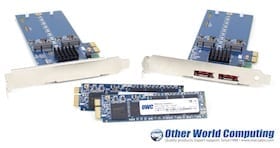
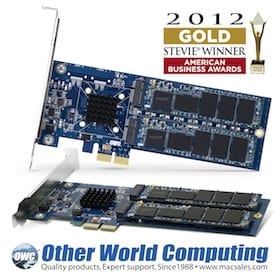



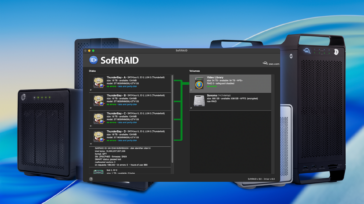
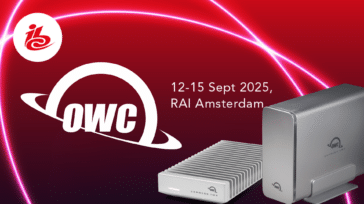



Can you use the Bootcamp to boot from a SATAIII SSD attached to the eSATA 6Gbps port on one Mercury Accelsior_E2 card installed in a 2012 Mac Pro? Thanks, Al
The only difference between the external ports and the internal ports is that the internal ports are configured as RAID 0. This configuration can be changed by putting the card in a PC and pressing Control-M at startup (I guess M is for Marvell). If you remove the RAID 0 configuration, then the internal SSDs will act exactly the same as a 6G SSD connected to the external SATA ports. You could probably even configure a RAID 0 with the external SSD ports or maybe both the external and internal ports (I haven’t tried it).
You will probably be able to boot Windows from the external SSD. In my Mac Pro 2008, I can boot Windows from the Accelsior’s RAID 0 but I have to wait 10 minutes because the Accelsior is slowed way down during the BIOS boot process. Also, I had to put the Accelsior in slot 1 because Boot Camp would not work if it was in slot 2 (this is the case with newer graphics cards installed – older graphics cards can remain in slot 1). I decided to put Windows on a 3G SSD in one of the four Mac Pro drive bays which boots quickly.
Since you have a Mac Pro 2012, you may have a better experience because the Boot Camp firmware is newer and all your slots are PCIe 2.0. The Mac Pro 2012 is basically just an upgraded version of the Mac Pro 2010. Try searching for comments about the Mac Pro 2010 and the Accelsior.
http://blog.macsales.com/13681-owc-announces-mercury-accelsior-as-industrys-first-fully-macintosh-and-pc-supported-bootable-pcie-ssd-card
The problem I mentioned before with the Accelsior and CalDigit FASTA-6GU3 6G eSATA & USB 3.0 Card doesn’t exist when the Accelsior is in slot 1, graphics card in slot 2 (covers slot 3), and the CalDigit is in slot 4.
What I would like to see for the current Accelsior is a Mac OS X utility like the Marvell RAID Utility which can change the Accesior’s configuration without needing to use a PC’s BIOS. Also, this utility should be able to remove the Marvell BIOS screen and startup delay.
A future Accelsior should use a better raid controller with 4 lane PCIe 2.0
The Accelsior E2’s eSATA ports do not support booting, so that setup would unfortunately not work.
I can no longer find the specs for the original Accelsior cards – how does the new e2 version differ from the original other than adding the very useful eSata ports?
I currently RAID 2 of the original cards & have an eSata card in the remaining slot … seems like I can now have 3 accelsiors by using the built-in eSata ports on the e2… do I need all 3 to be the e2 version to RAID or can I add an e2 board & RAID that with my 2 existing Accelsiors without compromising anything?
Looks like the original Accelsior overview page is gone, but you can still see the specs in the individual product pages.
http://eshop.macsales.com/item/OWC/SSDPHWE2R480/
http://eshop.macsales.com/item/OWC/SSDPHW2R480/
The numbers are the same, but the review at MPG says there’s a slight performance increase even after using the same flash modules from the old Accelsiors. I wonder how the controller chips have changed…
http://macperformanceguide.com/Reviews-SSD-OWC-Mercury-Accelsior-E2-upgrading.html
The same review also has performance for a triple raid of the old Accelsiors. The new Accelsiors should allow the same. Disk Utility will allow you to RAID any number of drives and partitions together. The total performance will be something up to the number of devices times the slowest device speed since RAID 0 divides the work equally between all devices.
The Accelsior is a PCIe 2.0 x 2 card with a max throughput of 1000 MB/s which is not really enough for two SATA 6G devices (600 MB/s each). The Accelsior E2 can have four SATA 6G devices. Performance will be less than maximum for each device if you try to read from the Accelsior’s on board RAID and the eSATA ports at the same time. I wonder if there would be any performance increase if you first software RAID the two eSATA ports then software RAID that with the on board RAID.
On the other hand, since the Accelsior is a x2 card, it might have better eSATA performance (while you’re not reading from the Accelsior’s on board RAID) than a x1 eSATA card if you have an eSATA device that can do more than 500 MB/s.
Joe, MPG is a useful resource but YMMV is always a factor & I have from time to time found some details presented their aren’t always what I get.
e.g. from MPG:-
> For RAID-0, use the Options… button to specify a 64K stripe size. That is not necessary, but is the best choice for SSDs.
I think the best choice still depends on your typical usage.
I can’t check right now what my stripe size over 2 Accelsiors is because I’m running Windows on that Mac Pro, but I do know I got measurably greater throughput specifying a larger stripe size which also seems to suit reading/writing video files.
I know my Accelsior performance numbers are measurably & consistently higher than those published by MPG, even using their own tools for benchmarking.
The SSD portion of the Accelsior_E2 is the same as the original Accelsior. The Accelsior_E2 offers the same great performance and reliability of the Accelsior with the addition of its 2 eSATA 6G ports.
Combining the Accelsior_E2 with 2 Accelsiors in a RAID 0 should work, however we have not tested the setup ourselves.
Thanks OWC Ben M, I have ordered a new E2 card to replace my eSata card & will put it through my testing.
I will be very interested in seeing the details of your upgrade program to see if it is worthwhile upgrading my other 2 Accelsiors. If it is reasonably priced I may upgrade. These cards have been super reliable.
Why is there such a dramatic decrease in write performance over a thunderbolt enclosure, specifically in comparison to the Sonnet Tempo SSD Pro?
Nice. Well done. I’ve been anticipating these for a while. A few months back I noticed that for a time they were listed on your site as forthcoming, though unannounced. Very pleased when I saw them finally pop back up the other day.
Just how well do these Mercury Accelsior_E2 SSDs handle incompressible vs compressible data?
Assuming there is a R/W performance differential with respect to incompressible data, is the *relative* difference in throughput more comparable to that of the OWC Mercury EXTREME Pro 6G, or, to that of the OWC Mercury Electra 6G? (Given the NAND spec you’ve listed, I rather suspect the former, than the latter.)
Also, while I assume this is true, can you confirm that Mac Pros can be booted from a RAID 0 array of 2 X Mercury Accelsior_E2 PCIe SSDs, using Mac OS X 10.6.8 and later?
I’m aware that using such a software RAID would preclude having an OS X Recovery partition, or using later versions of FileVault, on the RAID. I also understand that apparently having more than one Accelsior_E2 SSD installed precludes booting Windows via Bootcamp on *any* Accelsior_E2 that’s connected — although, presumably Windows could still be booted from an OWC Mercury SATA SSD installed in the same Mac Pro.
Thanks!
These are are excellent questions to ask. The Accelsior_E2, as you mentioned, uses synchronous NAND Flash on the Accelsior just like the Mercury Extreme Pro 6G. Synchronous NAND Flash handles incompressible files more efficiently than Asynchronous NAND Flash.
Creating a software RAID between two Accelsior_E2s will work perfectly with Mac OS 10.6.8+.
I am unable to use Boot Camp with a two of the old Accelsiors installed even if the Boot Camp partition is not on an Accelsior. That might just be a limitation of the Mac Pro 2008. The Accelsior compatibility page doesn’t mention this case at all.
I am also unable to use Boot Camp when both an Accelsior and a CalDigit FASTA-6GU3 6G eSATA & USB 3.0 Card is installed but the symptoms are slightly different. When there are 2 Accelsiors, the Accelsior BIOS boot screen does not appear, but when the CalDigit card is installed (instead of a 2nd Accelsior), the Accelsior BIOS boot screen does appear. I wonder if having other eSATA cards installed will cause the same problem.
Eh? That’s not cool.
Not cool at all.
Can anyone else confirm or refute that the presence of two or more Accelsiors completely prevents using Boot Camp, even if the Boot Camp partition is on a separate *internal drive* not on an Accelsior?
Or, can someone clarify all the specific criteria required to use Boot Camp when one, or more, Accelsiors are installed?
[Note: In any case, recall Boot Camp generally only works if the Boot Camp partition is on an internal drive, using one of the Mac’s standard internal interfaces.]
Using Boot camp on a MacPro currently only allows a single Accelsior to be installed. This is mentioned in the “Compatibility” section of the Accelsior E2 product page: “Bootcamp. To boot Windows via Bootcamp on Accelsior_E2, only one Accelsior_E2 SSD can be installed.” This restriction only applies to Macs running boot camp. Windows PCs can run multiple Accelsiors without issue.
“To boot Windows via Bootcamp on Accelsior_E2, only one Accelsior_E2 SSD can be installed.’
Yes, I saw that. And, that statement on the product page clearly specifies “To boot Windows via Bootcamp *on* Accelsior_E2…”
Which, would seem to imply it would be possible to boot Windows via Bootcamp *on* a separate, *independent,* non-Accelsior internal drive, even if more than one Accelsior is installed.
After all, why would one assume that having Accelsiors installed would affect booting off of OTHER internal drives?
Yet, I did not assume anything — it was one of my original questions, in my first comment you responded to, above. I tried to be very clear about that.
However, it now seems clear from the MPG report and what you’ve said here, “Using Boot camp on a MacPro currently only allows a single Accelsior to be installed.” Or rather, Boot Camp cannot be used at all in a Mac Pro with more than one Accelsior installed.
Thank you very much for the clarification! :)
Someone may wish to clarify the statement on the product page, to alleviate possible confusion others may also have.
So the next obvious questions are:
=> Does having one that one Accelsior in a Mac Pro affect runnning Windows and/on Linux in virtual machines? If so, how?
=> With a MacBook Pro, does having more than one Accelsior connected using multiple Mercury Helios chassis via Thunderbolt prevent Boot Camp from working?
Thanks!
Just to muddy the waters here….
With the original Accelsiors, I have 2 installed.
I also use bootcamp to boot Windows from a separate internal SSD.
I have no problem booting into Windows through bootcamp… it just takes waiting 10 minutes for the Accelsior cards to boot. Then things go along just fine.
hopefully the e2 won’t change this. ( or at least shorten the wait time :) )
Note, I was unable to install OS X on a RAID 0 across both Accelsior cards… I had to setup OS X on a single Accelsior partition & then setup RAID 0 across the remaining space.
In addition to booting Windows through Bootcamp on a separate (non-Accelsior) SSD while having 2 original Accelsior’s installed I can also now confirm that replacing one of those original Accelsior’s with a _e2 version, that I can continue to boot Windows on my Mac Pro.
I haven’t (yet) been successful doing so with 3 Accelsior cards (both originals plus _e2).
Initialization of Windows via Bootcamp seems to be sensitive to which PCIe slots are used in combination.
Botting in OS X with all 3 Accelsior cards just works.
Perhaps the phrase “To boot Windows via Bootcamp on Accelsior_E2” should be changed to “To boot Windows via Boot Camp on Mac Pro”.
Boot Camp is several things that allow you to run Windows or any other legacy OS on Mac:
1) Boot Camp firmware – Part of the Mac’s built in EFI firmware to emulate a PC’s BIOS to boot legacy OS’s like Windows and Linux. Includes changes to the Startup Manager that allow selecting legacy OS disks for booting.
2) Boot Camp Assistant – for partitioning your hard drive and downloading Boot Camp drivers and creating a Windows installer on DVD or flash drive.
3) Boot Camp drivers – Drivers provided by Apple to be installed in Windows to make Windows work better with the Mac hardware.
#2 can be done manually using other utilities. For #3, you can get the drivers directly from the device manufacturers.
#1 is the important part and is the reason for all the problems we’re having with third party PCIe cards like the Accelsior. People used to install Windows on Mac using an open source solution (source code no longer available?) on top of EFI until Apple provided the Boot Camp solution which had better compatibility especially with graphics cards. That’s kind of sad, because fixing Apple’s close sourced firmware is a bit more difficult than fixing an open source project. I don’t think it’s impossible but it would take a long time.
From MPG:
“One reader reports that a RAID-0 stripe (Mac format) or maybe just two Accelsior cards makes Windows (via BootCamp) unhappy about booting; this is as you see it, MPG has not tested this scenario:
“When two cards are present all I get is a black screen when I try to boot from a Windows drive or Even a Windows 7 install disk. A single card is fine.” (Last updated April 16, 2012 — bottom of page)
http://macperformanceguide.com/Reviews-SSD-OWC-Mercury-Accelsior-setup.html
Ok, that not even being able to boot from a Windows 7 install disk does not bode well for using Boot Camp at all whatsoever with two or more Accelsiors in place. (Presumably one could still use Windows and Linux virtual machines, however, even if they’re hosted on a 2 X Accelsior RAID 0 array — though this would need to be confirmed by someone.)
>
“When two cards are present all I get is a black screen when I try to boot from a Windows drive or Even a Windows 7 install disk. A single card is fine.” (Last updated April 16, 2012 — bottom of page)
>
I don’t know what Mac Pro version this refers to, but that is exactly what I see on my 6-core Westmere 3.33GHz 2010 model – just be patient — after about 10 minutes the Accelsior Boot screen will appear, and then again for the second card. Then Windows booting will proceed. Booting into OS X is unaffected & there is no delay. I’m guessing if you have a slower machine or different resource configuration (mine has 32GB & loads of drives, upgraded graphics card etc), then it’s possible the time to wait may be longer.
Now, can you cram that into the new iMac?
Into an iMac internally? Not without a shrink ray – and even then, what would we connect it to?
However, when installed in an OWC Mercury Helios, you can use the card via Thunderbolt externally.
That was just my polite way of asking about any progress on a turn key program for the new iMacs….